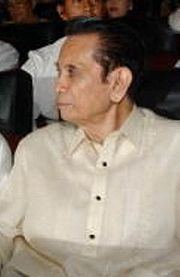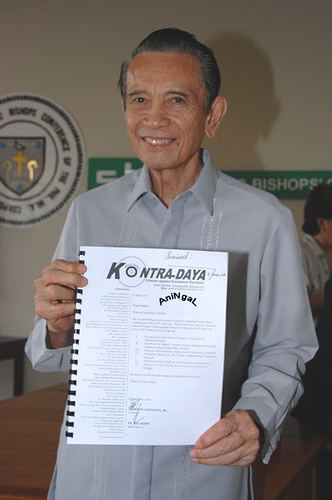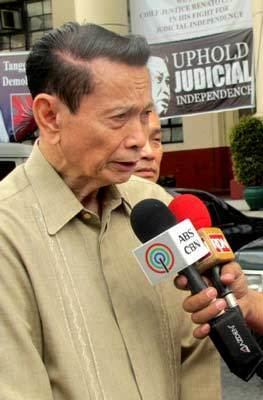Spouse Ruth de Lara Preceded by Domingo Siazon Parents Teofisto Guingona, Sr. | Name Teofisto Jr. Children TG Guingona Role Filipino Politician | |
 | ||
President Gloria Macapagal-Arroyo Preceded by Gloria Macapagal-Arroyo President Gloria Macapagal-Arroyo Succeeded by Gloria Macapagal-Arroyo Similar People TG Guingona, Fidel V Ramos, Manuel Roxas | ||
Teofisto guingona jr
Teofisto Tayko Guingona Jr. (born July 4, 1928) is a Filipino politician who is the 11th and former Vice President of the Philippines from 2001 to 2004, during the first term of President Gloria Macapagal-Arroyo. Born in San Juan, Rizal (now San Juan, Metro Manila), Teofisto is a graduate of Ateneo de Manila University, where he was a working student.
Contents
- Teofisto guingona jr
- NTL Mayor na asawa ni ex VP Teofisto Guingona Jr tinambangan
- Early life and career
- 1971 Constitutional Convention
- Chairman of the Commission on Audit
- Senator of the Philippines 198793 19982001
- Executive Secretary 199395 and Secretary of Justice 199598
- Vice President 200104
- Post vice presidency
- Personal life
- References

He was appointed as Chairman of the Commission on Audit by then newly installed President Corazon C. Aquino in 1986 until 1987, when he was elected as a Senator of the Philippines under the coalition of Lakas ng Bayan, led by Aquino. While a senator, he also served as the director and chairman of the Mindanao Development Authority and the Mindanao Labor Management Advisory Council. He won in the reelections in 1992 and became Majority Leader a year after, but his term ended prematurely when newly elected President Fidel V. Ramos appointed him as Executive Secretary from 1993 until 1995 and as Justice Secretary from 1995 until 1998. He was reelected to the senate again as a Minority Leader from 1998 until 2001.
Guingona was appointed as Vice President of the Philippines and Secretary of Foreign Affairs by President Gloria Macapagal Arroyo, after she was automatically promoted to presidency from vice presidency after the then President Joseph "Erap" Estrada's ousting in EDSA II. When Guingona's term ended, he decided not to seek a full term election and was succeeded by Noli de Castro.

NTL: Mayor na asawa ni ex-VP Teofisto Guingona Jr., tinambangan
Early life and career

Guingona was born on July 4, 1928 in San Juan, Rizal. His father, Teofisto Guingona, Sr., was a former assemblyman, senator, judge and commissioner from Guimaras, Iloilo. His mother, Josefa Tayko, is of Siaton, Negros Oriental. He grew up in the provinces Agusan, Lanao, and Misamis Oriental, where he completed his elementary schooling with honors in Ateneo de Cagayan.

He pursued his studies at the Ateneo de Manila University as a working student, teaching history and political science while taking up courses in law and economics. He took up special studies in Public Administration, Economics, Sociology and Audit. After graduation, he went into business and became a Governor of the Development Bank of the Philippines and President of the Chamber of Commerce of the Philippines.
1971 Constitutional Convention
Guingona was a delegate to the 1971 Constitutional Convention and when martial law was declared in 1972 by President Ferdinand Marcos, he resisted the abuses of the regime, serving as a human rights lawyer. He founded SANDATA and became the honorary chairman of BANDILA, two mass-based organizations dedicated to social and economic reforms. Because of his opposition to martial rule he was jailed twice, first in 1972 and then in 1978.
Chairman of the Commission on Audit
When Marcos was ousted as a result of the People Power Revolution, newly installed President Corazon Aquino appointed Guingona as Chairman of the Commission on Audit where he gained renown as a graft buster.
Senator of the Philippines (1987–93; 1998–2001)
Guingona was first elected to the Senate in 1987 under the Aquino-backed Lakas ng Bayan coalition. He was elected as Senate President pro tempore in 1987 and Majority Leader in 1990.
Additionally, he served as director and chairman of the Mindanao Development Authority and the Mindanao Labor Management Advisory Council.
In 1992, he ran for reelection under the Laban ng Demokratikong Pilipino of Speaker of the House Ramon Mitra Jr. and won, placing 14th in the Senate race. He became Majority Leader again in 1993 but his term in the Senate was cut short when President Fidel V. Ramos appointed him as Executive Secretary the same year.
In 1998, he was elected again to the Senate under the Lakas-NUCD and was elected as Minority Leader. He boldly spoke out against the anomalies in the administration of President Joseph Estrada and was among the first to call for his resignation. Guingona exposed the graft and corruption, plunder, culpable violations of the Constitution, and cronyism in the Estrada administration that led to the impeachment trial of Estrada by the Senate. On January 17, 2001, he was one of the senators who voted in favor of opening an envelope that was said to contain incriminating evidence against Estrada. The final vote was 11-10, in favor of keeping the envelope closed, which further fueled anti-Estrada sentiments that led to another uprising in EDSA. When Estrada was ousted, Guingona emerged as the top choice for a successor to Vice President Gloria Macapagal-Arroyo, who succeeded Estrada as president.
Executive Secretary (1993–95) and Secretary of Justice (1995–98)
President Fidel V. Ramos appointed him as Executive Secretary in 1993, replacing Edelmiro Amante, who resigned.
In 1995, he was appointed as Justice Secretary. As Justice Secretary, he rejuvenated the Witness Protection Program and established the Prosecution Academy. He also implemented the Katarungang Pambarangay and heightened public awareness of the Barangay Justice Program. He also held, in a concurrent capacity, the chairmanship of the Presidential Anti-Crime Commission.
Vice-President (2001–04)
Following the EDSA II Revolution in 2001, Guingona was appointed as Vice President of the Philippines by Arroyo on 7 February. He also concurrently served as Secretary of Foreign Affairs. During his time as vice-president, he was often at odds with Arroyo, particularly over foreign policy. He resigned as Secretary of Foreign Affairs on July 2, 2002. He also resigned from the Lakas-NUCD on October 3, 2003, citing "corruption and unfulfilled reform promises."
In the 2004 Philippine elections, Guingona did not seek a full term election and was succeeded by Noli de Castro. In that election, he controversially supported the presidential and vice-presidential bids of opposition candidates Fernando Poe Jr. and Senator Loren Legarda, respectively.
Post vice-presidency
After the defeat of his candidate Fernando Poe Jr., Guingona supported the administration of Arroyo again by accepting the position of Ambassador to China. He resigned as ambassador and joined the opposition again at the height of the Hello Garci scandal, a political scandal involving Arroyo's rigging of the 2004 presidential elections.
On November 29, 2007, Guingona participated in the Manila Peninsula rebellion, a mutiny led by Senator Antonio Trillanes IV and Brigader General Danilo Lim that called for Arroyo's resignation. He was arrested afterwards but on December 13, 2007, the Makati City Regional Trial Court dismissed rebellion cases against him.
Guingona wrote his 346-page book Fight for the Filipino, which contains his memoirs. It was launched on July 4, 2008, his 80th birthday, at the Manila Hotel.
Personal life
He is married to Ruth de Lara, former mayor and incumbent vice mayor of Gingoog City, Misamis Oriental. His son, Teofisto III is a former Senator of the Philippines. While his daughter Stella Marie, is the incumbent mayor of Gingoog.
